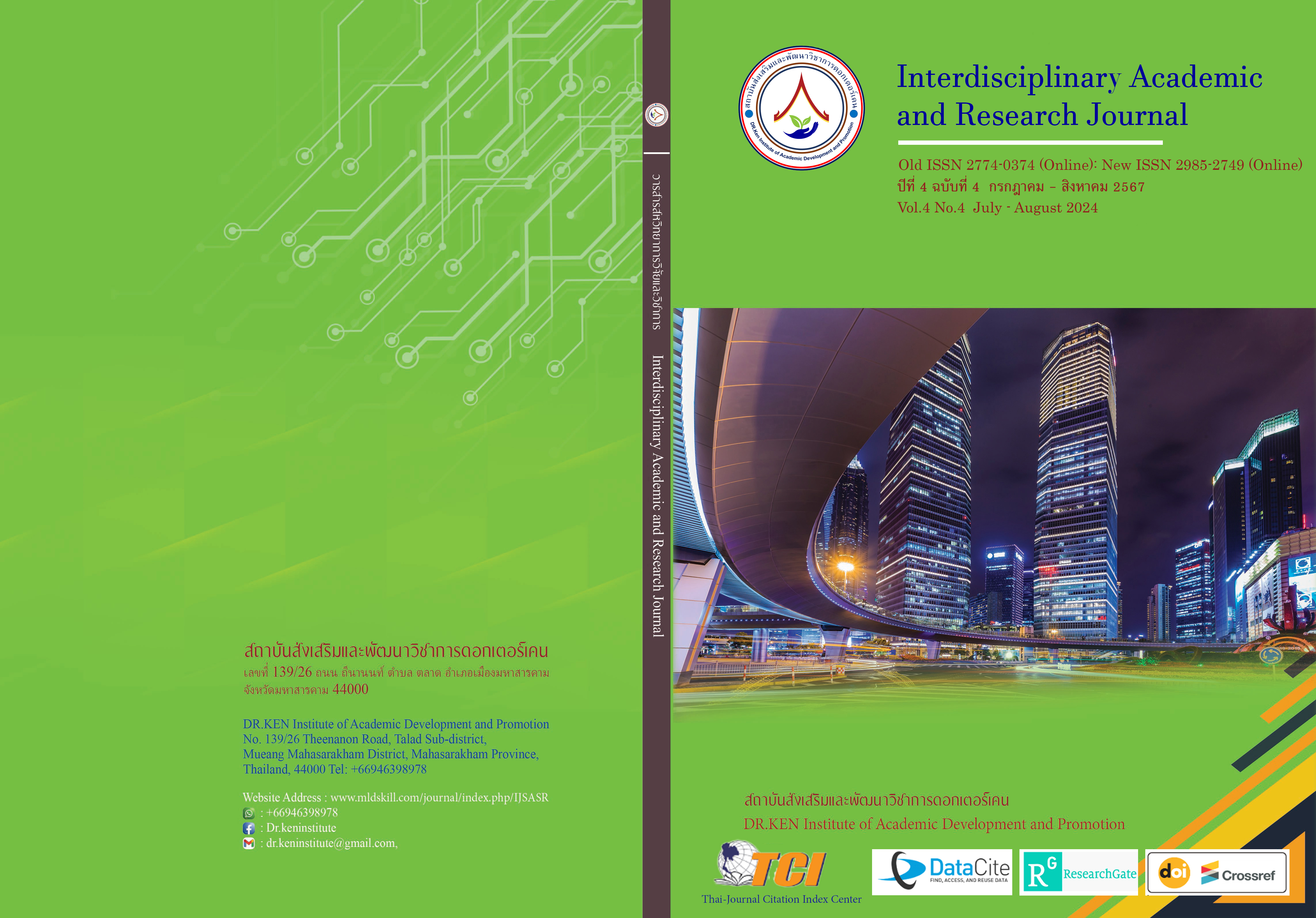The Development of Holistic Integrated Management as Local Learning Resources Center at Nam Jang, Mae Ta District, Lampang Province
DOI:
https://doi.org/10.60027/iarj.2024.277087Keywords:
Management;, Local Learning Resources Center; , Holistic IntegratedAbstract
Background and Aims: Fostering comprehensive and coordinated approaches to education and community development requires holistic integrated management. These centers can effectively address the diverse needs of learners, encourage lifelong learning, and support the general sustainability and well-being of local communities by integrating a variety of resources and services. Thus, the purposes of this research were 1) to study establishments in the community that are conducive to local learning and 2) to manage personnel in the establishments to be friendly towards local learning.
Methodology: The target group was 20 people who are local learning resources at BanKiew Subdistrict, Mae Tha Subdistrict, Na Krua Subdistrict, and Pa Tan Subdistrict, by random sampling (cluster sampling). Mixed methods consisted of Qualitative Research and Participatory Action Research (PAR). The instruments were 1) a general information questionnaire, 2) in-depth interviews, and 3) a questionnaire: Concerning the development of personnel in the workplace to be friendly to local learning. The data was analyzed by using percentage, average, and standard deviation.
Results: The results of the study were as follows: (1) Establishments in the community that facilitate local learning classified into 5 parts as follow: 1) personnel in establishments, most were women of 40-49 years old and education level lower than Mathayom 3. 2) In general information, they were a source of learning about products from the community, a source of agricultural learning and a religious place. 3) In terms of the problem was product development and 4) support from government agencies in the form of skills and career development projects in workplaces. (2) The personnel development in establishments towards local learning found that 2.1) a learning process in the establishment as a whole was at a high level. The item with the highest level was Learning from generation to generation. 2.2) personnel participation in establishments as a whole was at a moderate level. The item with the highest level was participating in providing information. 2.3) The potential to manage establishments as a whole was at a high level. The item with the highest level was recommended establishments. 2.4) The agency supported as a whole was at a high level. The highest level was to publicize it to make people in the community aware of its value. And 2.5) Integrated and holistic management of local learning resources consisting of 3 parties including the government sector, academic, and public sectors.
Conclusion: (1) Most of the establishments in the community that facilitate local learning were products from the community, agriculture, and a religious place. (2) Personnel development in establishments was as follows: 1) a learning process in the establishment was at a high level. 2) personnel participation in establishments was at a moderate level. 3)The potential to manage establishments was at a high level. 4) The agency support was at a high level. And 5) the integrated and holistic management of local learning resources consisted of 3 parties including the government sector, academic, and public sectors.
References
กระทรวงศึกษาธิการ (2547). การใช้แหล่งเรียนรู้ในโรงเรียนและชุมชน. กรุงเทพฯ: , สำนักงานคณะกรรมการการศึกษาขั้นพื้นฐาน..
คัชพล จั่นเพชร และพิทักษ์ ศิริวงศ์. (2560). การบูรณาการทุนทางวัฒนธรรมสู่การเป็นแหล่งท่องเที่ยวเชิงสร้างสรรค์ด้วยกระบวนการมีส่วนร่วมของชุมชน:กรณีศึกษา ชุมชนบ้านชากแง้ว อำเภอบางละมุง จังหวัดชลบุรี. Journal of Community Development Research (Humanities and Social Sciences), 10(1), 111-121.
ชัชวาลย์ วงษ์ประเสริฐ. (2557). การจัดการความรู้ในองค์กรธุรกิจ. กรุงเทพฯ : เอ็กซเปอร์เน็ท.
ฐิติวัฒน์ เพชรถิรสวัสดิ์ (2566). กระบวนการถ่ายทอดภูมิปัญญาเพื่อการพึ่งพาตนเองของชาวบ้าน ตำบลภูเขาทอง อำเภอพระนครศรีอยุธยา จังหวัดพระนครศรีอยุธยา. วารสาร มจร การพัฒนาสังคม. 8(1), 341-356.
ทัศน์พล ชื่นจิตต์, ไอลดา มณีกาศ และณัฐธิดา ดวงแก้ว. (2566).การพัฒนาแหล่งเรียนรู้ภูมิปัญญาท้องถิ่น เพื่อการจัดการเรียนรู้ตามอัธยาศัยของกลุ่มชาติพันธุ์ขมุบนพื้นที่สูง จังหวัดเชียงราย. วารสารสถาบันวิจัยและพัฒนา มหาวิทยาลัยราชภัฏบ้านสมเด็จเจ้าพระยา. 8(2), 47-60.
นงเยาว์ อุทุมพร (2561). การบริหารจัดการแหล่งเรียนรู้ของชุมชนตามหลักเศรษฐกิจพอเพียงเพื่อนำไปใช้บูรณาการในการจัดการเรียนรู้ในสถานศึกษาอย่างยั่งยืน อำเภอบางพลี จังหวัดสมุทรปราการ. กรุงเทพมหานคร : คณะครุศาสตร์ มหาวิทยาลัยราชภัฏธนบุรี.
ปรีชา ธนะวิบูลย์ และนงเยาว์ อุทุมพร. (2562). การบริหารจัดการแหล่งเรียนรู้ที่เป็นภูมิปัญญาท้องถิ่นในชุมชนริมแม่น้ำเจ้าพระยาสายเก่าเพื่อใช้ในการศึกษาอย่างยั่งยืน. กรุงเทพมหานคร : คณะครุศาสตร์ มหาวิทยาลัยราชภัฏธนบุรี.
วิจารณ์ พานิช. (2555). วิถีสร้างการเรียนรู้เพื่อศิษย์ในศตวรรษที่ 21. กรุงเทพฯ : มูลนิธิสด ศรีสฤษดิ์วงศ์.
สุเทพ อ่วมเจริญ. (2557).การพัฒนาหลักสูตร : ทฤษฎีและการปฏิบัติ.พิมพ์ครั้งที่ 6. นครปฐม : โรงพิมพ์มหาวิทยาลัยศิลปากร วิทยาเขตพระราชวังสนามจันทร์.
Brown, E. (2019). "Utilizing Local Learning Resources: The Role of Museums in Education."Journal of Cultural Heritage Studies, 12 (3), 211-228.
Cohen , J.M., & Uphoff, N.T. (1981). Rural Development Participation: Concept And Measures for Project Design Implementation and Evaluation. Ithaca, NY: Rural Development Committee Center for International Studies, Cornell University.
Erwin, W. (1976). Participation Management: Concept, Theory, and Implementation. Atlanta, GA: Georgia State University.
Gustavo, W.C. (1992). The Meaning of Participation. In Brand, Peter.
Jarolimek, N.Y. (1969). Social Studies in Elementary Education. 3rd edition. New York: The Macmillan Company.
Oakley, P., & Marsden, D. (1986). Approaches to participation in rural development. Geneva: Switzerland.
Ramirez, E.C. (1954). Some Community School Practices. Quezon City: National Printing.
Whang, I.J. (1981). Management of rural change in Korea: The Saemaul Undong. Seoul: Seoul National University Press.
Downloads
Published
How to Cite
Issue
Section
License
Copyright (c) 2024 Interdisciplinary Academic and Research Journal

This work is licensed under a Creative Commons Attribution-NonCommercial-NoDerivatives 4.0 International License.
Copyright on any article in the Interdisciplinary Academic and Research Journal is retained by the author(s) under the under the Creative Commons Attribution-NonCommercial-NoDerivatives 4.0 International License. Permission to use text, content, images, etc. of publication. Any user to read, download, copy, distribute, print, search, or link to the full texts of articles, crawl them for indexing, pass them as data to software, or use them for any other lawful purpose. But do not use it for commercial use or with the intent to benefit any business.
















.png)


